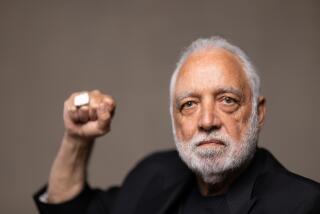The Labor Leader Who Helped Clear a Path for Civil Rights
- Share via
If one event, above all others, in the career of Martin Luther King Jr. helped the cause of racial justice in this country it was the “I Have a Dream” speech, given on this day in 1963.
Since that day, the speech has come to be a classic of American oratory.
On the steps of the Lincoln Memorial, King contrasted the hope black people had 100 years earlier, in the year of Emancipation, with the despair of blacks in 1963.
In his powerful, ringing cadence, King said: “Now is the time to rise from the dark and desolate valley of segregation to the sunlit path of racial justice. Now is the time to open the doors of opportunity to all of God’s children. Now is the time to lift our nation from the quicksands of racial injustice to the solid rock of brotherhood.”
The wonderful rhetoric and the passion were King’s; the occasion and the context were the work of A. Philip Randolph.
Randolph had been the main force in the civil rights struggles of the 1940s and ‘50s, and it was he who introduced King on that historic afternoon. As president of the Brotherhood of Sleeping Car Porters for three decades, it was Randolph who had--until Aug. 28, 1963--set the agenda for the civil rights struggle.
In January 1941, as the country was gearing up for World War II, black Americans could not get jobs in defense plants.
As a labor leader, Randolph was furious. He proposed a protest march down Pennsylvania Avenue, and thus began what came to be known as the March on Washington Movement.
Randolph was called to Washington to meet with the president and members of the Cabinet, all of whom were convinced that a protest march as the country was getting ready for war would be harmful to the national interest. But Randolph insisted that it was unacceptable for black people to be turned away at the gates of defense plants.
Franklin D. Roosevelt said he would speak to heads of corporations and urge them to provide blacks with equal opportunities to work. Randolph wanted the president to issue an executive order making equal opportunity in defense plants mandatory. Otherwise, he said, 100,000 blacks would march. In fact, in the course of the discussion, Randolph upped the ante. He wanted an executive order that prohibited job discrimination throughout the federal government.
Roosevelt gave in, and no march was held. A week after the meeting, the president signed Executive Order 8802, which asserted that it was U.S. policy “that there shall be no discrimination in the employment of workers in defense industries because of race, creed, color or national origin.”
When the Japanese surrendered in August 1945, the armed forces were still segregated. When President Harry S. Truman sent a bill to Congress for a new military draft, there was nothing in it prohibiting segregation. Randolph became an organizer of the Committee Against Jim Crow in Military Service.
A scenario then played out that was similar to the one with Roosevelt seven years earlier.
Randolph let it be known that if segregation in the armed forces was not stopped, he would urge the nation’s youth to ignore the draft. Randolph and other black leaders were invited to a meeting with Truman. Randolph testified before the Senate Armed Forces Committee. Randolph and his followers picketed at the 1948 Democratic National Convention, carrying signs reading: “Prison is better than army Jim Crow service.”
Unless there was legislation or an executive order that would end Jim Crow in the services, Randolph was going to urge civil disobedience against the draft.
On July 26, 1948, Truman issued Executive Order 9981, which called for an end to segregation in the military as rapidly as possible.
The 1963 March on Washington had its origins in a conversation between Randolph and his associate, Bayard Rustin. A march on Washington for jobs and freedom, they thought, would provide dramatic support for the anti-segregation demonstrations King was orchestrating in the South. Now it was President John F. Kennedy who was worried about violence and political backlash. At the end of July, Randolph was again at the White House.
Kennedy was afraid his efforts to cultivate congressional support for civil rights legislation would be sabotaged by the march. But Randolph was adamant.
A disciplined and inspirational march took place Aug. 28. King made his speech, and in the months that followed, the two most important pieces of civil rights legislation since Reconstruction were passed: the Voting Rights and Public Accommodations acts.
More to Read
Get the L.A. Times Politics newsletter
Deeply reported insights into legislation, politics and policy from Sacramento, Washington and beyond. In your inbox three times per week.
You may occasionally receive promotional content from the Los Angeles Times.










